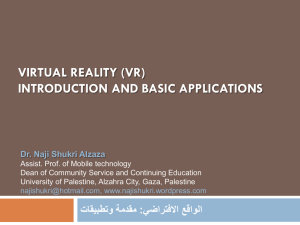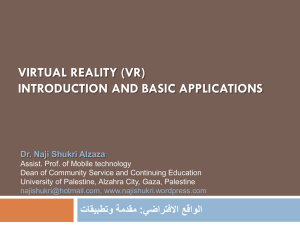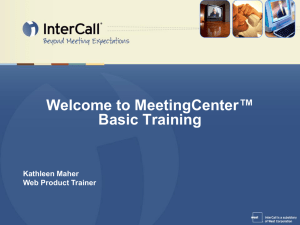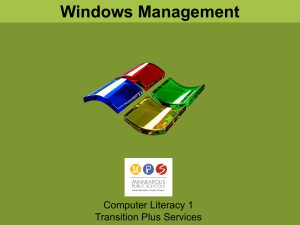VR Systems - WordPress.com
advertisement
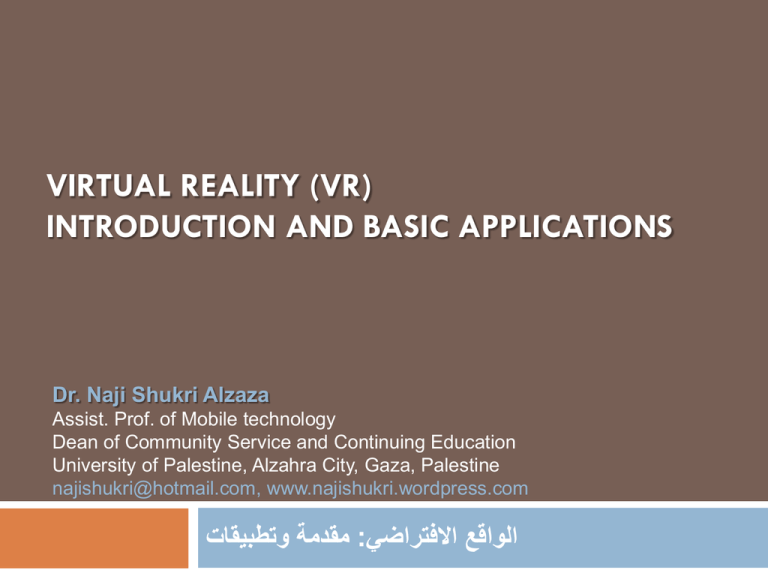
VIRTUAL REALITY (VR) INTRODUCTION AND BASIC APPLICATIONS Dr. Naji Shukri Alzaza Assist. Prof. of Mobile technology Dean of Community Service and Continuing Education University of Palestine, Alzahra City, Gaza, Palestine najishukri@hotmail.com, www.najishukri.wordpress.com مقدمة وتطبيقات:الواقع االفتراضي 2 Objectives 3 Students should be able to understand the: Classification of VR system Non-immersive (desktop) Semi-immersive Fully-immersive Comparison between the various VR system Dr. Naji Shukri Alzaza VR Systems 4 Model or Simulation Virtual Environment Representation Output User(s) Input Peripheral Technologies Virtual Reality System Architecture Dr. Naji Shukri Alzaza VR Systems 5 VR systems are characterized by the following features: Sense of presence (being there) in 3D computer generated environment. Sense of immersion (deeply engaged or involved). High degree of interactivity (interacting with a human user). Real-time (of or pertaining to applications in which the computer must respond as rapidly as required by the user or necessitated by the process being controlled) response. Dr. Naji Shukri Alzaza VR Systems 6 VR systems can be categorized into: 1. Non-Immersive (Desktop) 2. Semi-Immersive 3. Fully-Immersive Dr. Naji Shukri Alzaza 1. Non-immersive (Desktop) 7 Presents images on a monitor and user interacts with the images using mouse, joystick and keyboard. Although the user is not technically immersed, it is still considered as a VR system as it could be compared to viewing a real world through a window. Other terms used: Desktop VR and Windows on World System. Advantage: the cost is significantly lower than other forms of VR system. Desktop VR system provides almost no sense of immersion. For some applications this may be acceptable but where perception of scale is important then this can be a serious problem. Dr. Naji Shukri Alzaza 1. Non-immersive (Desktop) 8 Advanced Desktop VR System Typical Desktop VR System Dr. Naji Shukri Alzaza 2. Semi-immersive VR 9 User is partially immersed in a VE. Comprises of a relatively high performance graphics computing system which include large screen monitor, large screen projector system or multiple television projection systems. Projection system uses wide field of view FOV in access of 60° which could increase the feeling of immersion or presence experienced by the user. Dr. Naji Shukri Alzaza 2. Semi-immersive VR 10 The resolution of projection systems ranges from 1000 3000 lines but to achieve the highest levels it may be necessary to use multiple projection systems which are more expensive. Stereographic imaging can be achieved, using some type of shutter glasses in synchronisation with the graphics system. Provides a greater sense of presence than nonimmersive systems and also a greater appreciation of scale. Images provided are of a higher resolution than Head Mounted Displays (HMDs). Dr. Naji Shukri Alzaza 2. Semi-immersive VR 11 Dr. Naji Shukri Alzaza Workbench and wall 2. Semi-immersive VR 12 3. Fully-immersive VR 13 Based on the immersive VR technology, providing a feeling of presence in the virtual world. Allows users to step into the virtual world by means of devices that will map them into the digital world. Head Mounted Display (HMD) provides stereoscopic (3D) images and audio signals to create binaural (hearing with two ears) sound in order to influence the user’s perception of the world around him/her. Fully immersive VR systems tend to be the most demanding in terms of the computing power and level of technology. Dr. Naji Shukri Alzaza Head Mounted Display (HMD) 14 Dr. Naji Shukri Alzaza Cave System 15 Dr. Naji Shukri Alzaza Cave System 16 Dr. Naji Shukri Alzaza Cave System 17 Dr. Naji Shukri Alzaza Non-Immersive vs Fully- and Semi-Immersive Virtual Environments 18 Non Immersive: delivered by a conventional desktop monitor and standard interaction devices such as joystick, keyboards and mouse. Does not demand the highest graphics performance thus a normal PC can be used. The reduction of the computer’s price with increasing graphics performance would make a desktop VR system extremely attractive for many applications. Non-immersive VE creates a comfortable interaction between user and the system. Users are usually aware of the real world and only observe the virtual world through a monitor. Unlike immersive devices like HMD, desktop VR does not require any devices to be attached to the body. HMD causes simulator sickness. Dr. Naji Shukri Alzaza Non-Immersive vs Fully- and Semi-Immersive Virtual Environments 19 An immersive VE user typically turns his/her head often, as one would do in the real world, and the human neck is good at doing fast and accurate rotation. Unfortunately, this fast motion exacerbates (make worse) the effects of the lag (fail to maintain a desired pace or to keep up), with the result that some immersive VE systems can take up to a 0.5 second to stop the world from spinning around the user. In non-immersive systems, the movement of the input devices, such as mouse or 6DOF (Degree of Freedom) input controllers are mapped to the position and orientation of the user. Current desktop technology is able to update the display in almost real time, thus the problem of lag is greatly reduced in nonimmersive systems. Dr. Naji Shukri Alzaza Non-Immersive vs Fully- and Semi-Immersive Virtual Environments 20 The cost of a non-immersive system is far lower than that of an immersive system. A non-immersive VE provides a practical solution for Web-based VE. Web-based VE provides visualisation via the Webbrowser and does not require sense of immersion. This could not be achieved using immersive or semi immersive VE as Web browser could not cater for other peripheral devices than mouse and keyboard. Dr. Naji Shukri Alzaza Comparison between various VE implementations (Kalawsky, 1996) Qualitative Performance Non-immersive VR (Desktop) Semi-Immersive VR (Projection) Full Immersive VR (Head- coupled) High resolution High 1000 - 3000 Low - medium 300 -1000 Scale (perception) Low Medium - high High Sense of situation awareness (navigational skills) Low Medium High Low 50° typically Medium 150° High 360° Low Low Medium - high None - low Medium - high Medium - high Main features Resolution Field of regard Lag Immersion Dr. Naji Shukri Alzaza 22 Dr. Naji Shukri Alzaza
